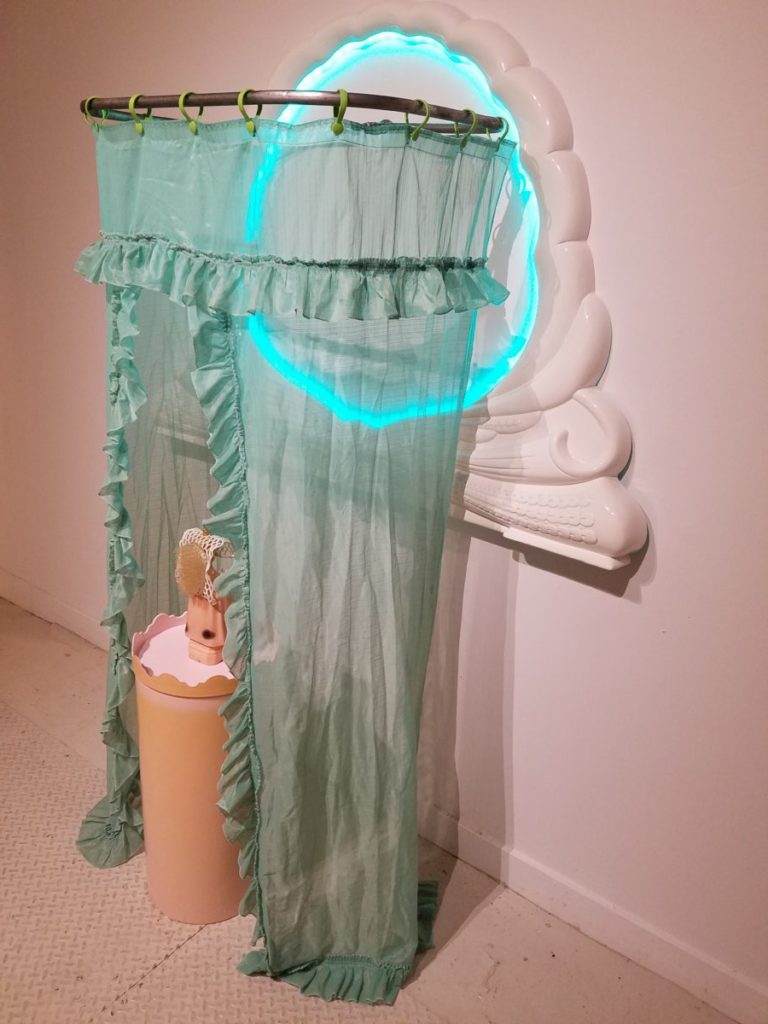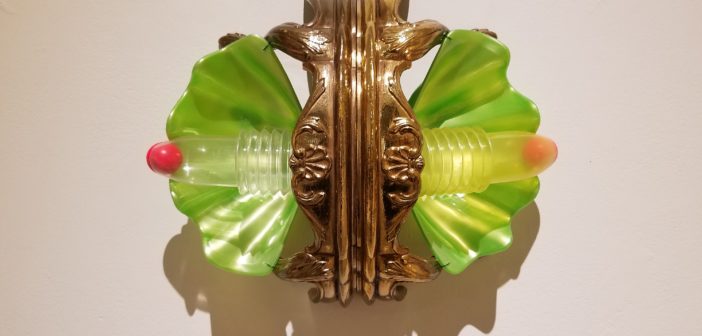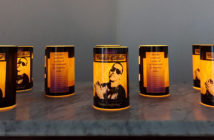Tatiana Klusak’s work examines the various social cues and cultural norms we become accustomed to as we grow up. Beneath the playful and humorous surface of her work lies feelings of doubt, strain, inefficacy, and confusion. I’ll Tell You When You’re Older, on view at The Distillery Gallery through July 22, evokes systems of religious veneration. Klusak intentionally disquiets the viewer with surreal assemblages of filigreed boxes, synthetic hair, toys, draperies, and amorphous masses, all of which remain untitled. As the exhibition title suggests, we may not be mature enough yet to grasp their spiritual importance. Tantalizing bewilderment mounts quickly as the unversed viewer attempts to read the objects.
A skein of human hair rests regally on a red chalice, which in turn rests on a flared red disk. A red piece of fabric, trimmed with lace, floats delicately atop it, drifting down to the base of the sculpture. After more looking, it is apparent that the red cloth is tailored like a cape, with a distinct hood-like section at the crown. A dreamlike disjuncture erupts. That a hood would touch hair is not remarkable; a delicate and precious tailored garment for a disembodied bundle of hair is a different matter altogether. Or is it? Does the peculiarity stem solely from our ignorance or is something else amiss? What is the hood meant to signify or protect? Perhaps it is acting as a Catholic reliquary, a container meant to house fragments of saints, be they purported belongings or a literal part of their body. Exactly whose hair it is is unknown, and that mystery fosters fascination and dread all at once.
The normality of this praxis vacillates frequently in this exhibit. Whether we fear or doubt or hope becomes murky as more time is spent seeking answers. They’ll tell us when we’re older, but for now, we know that something lies in wait.
 This distinct aura of inhabitation extends throughout the exhibit. A darkened alcove centers on a bassinet draped with ruffled sheer cloth. A caged object reclines in an illuminated frame for our edification. In the rear stands an illuminated basin swathed in satin. Infancy comes to mind with these items, but a looming red assemblage in the opposite corner disrupts the imagery and brings unknowns into my sparsely populated narrative of parent and child. Whether the red sculpture is the nurturer or a malign presence is thoroughly debatable. And these ambiguous bodily presences are everywhere.
This distinct aura of inhabitation extends throughout the exhibit. A darkened alcove centers on a bassinet draped with ruffled sheer cloth. A caged object reclines in an illuminated frame for our edification. In the rear stands an illuminated basin swathed in satin. Infancy comes to mind with these items, but a looming red assemblage in the opposite corner disrupts the imagery and brings unknowns into my sparsely populated narrative of parent and child. Whether the red sculpture is the nurturer or a malign presence is thoroughly debatable. And these ambiguous bodily presences are everywhere.
Near this darkened alcove is an array of tortured amalgams litter a long table; blond synthetic hair sprouts from mysterious orifices, syringe-like apparatus lies in a case fit for a prized family heirloom; an organism of hair, tulle and plastic reclines on a quilted satin mat; a fleshy mass with a knee brace wrapped gingerly about it slouches in an acrylic box. That some of the works appear tortured and writhing comes as no surprise. Images of suffering Catholic saints, fixed in their moments of triumphant bodily sacrifice, are numerous and elaborate. No living individual can officially be canonized by the Vatican, after all.
The most eye-catching piece is a take on depictions of Jesus as an infant. Whose child they are, however, is a mystery yet to be unveiled. Behind parted translucent curtains sits a pink figure on a pedestal. Two bleary eyes gaze out beneath a fusion of hair and headpiece. Above it, still partly obscured by the blue veil, glows a ring inside a billow and feathery molded relief. The privileged perspective is clear, and to see this altar resting on a plinth in other circumstances would not be surprising in the least. I confess to feeling intimidated by the stout childlike figure. As an onlooker, its regality is clear, though the underpinnings of that status remain obscure. Perhaps the child, too, remains uninitiated and confused by the cloying resplendence.
In due time, we will be educated on the matter. That dour and at times unsettling assurance palpably lingered with me after I departed. Tellingly, the specifics of these fictive religious arrays are never elaborated upon outright; we are left to reside in states of inclusion and ignorance simultaneously, ever on the cusp of knowing. The dynamic is effectively evinced and explored in I’ll Tell You When You’re Older. I can imagine being surrounded by these bizarre objects during my childhood with only the promise, “I’ll tell you when you’re older,” to pacify me in the meantime.




